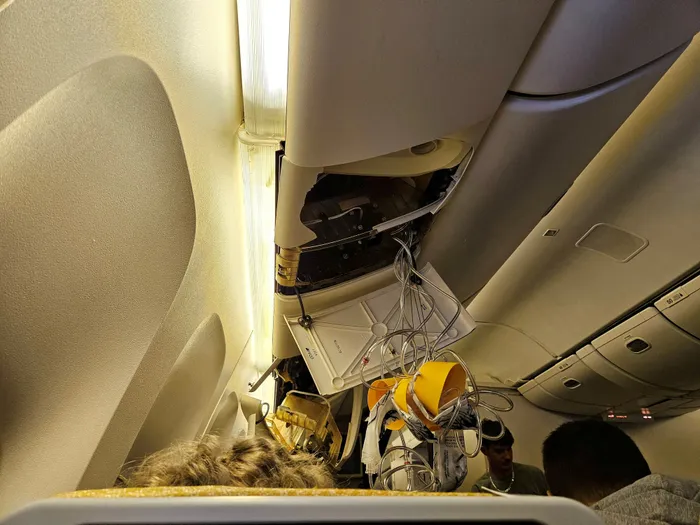Passengers relive flight from hell

The interior of Singapore Airlines flight SQ321 is pictured after an emergency landing at Bangkok's Suvarnabhumi International Airport, in Bangkok. Picture: Reuters
More than 140 passengers and crew from a Singapore Airlines flight on which one person died during heavy turbulence finally reached Singapore on Wednesday, with 20 still fighting for their lives in a Bangkok hospital.
The London-Singapore flight on a Boeing 777-300ER plane diverted to Bangkok for an emergency landing on Tuesday after the plane was buffeted by turbulence that flung passengers and crew around the cabin, slamming some into the ceiling.
A British passenger, 73, died of a suspected heart attack, an airport official said, and Bangkok’s Samitivej Hospital said 20 passengers were in intensive care, nine had undergone surgery, while five more were awaiting surgery.
Josh Silverstone, 24 from south London, woke up on the floor of the plane. “I didn’t realise what happened.
I must have got hit in the head. Lots of people hit their head. Everyone was bleeding,” he said as he left the hospital on Wednesday after being treated.
He had been heading to Singapore for a holiday before meeting friends in Bali. He said he still hopes to make it to the Indonesian island.
Many passengers in the hospital still being treated had spinal injuries.
“I am lucky to be able to walk,” he said.
Photographs of the interior of the plane showed gashes in the overhead cabin panels, oxygen masks and panels hanging from the ceiling and luggage strewn around. A passenger said some people’s heads had slammed into the lights above the seats and broken the panels.

“I saw people hitting the ceiling and landing in awkward positions. People getting massive gashes in the head; concussions,” said Dzafran Azmir, 28, a student onboard the flight.
Singapore Airlines flew 131 passengers and 12 crew on the relief flight from Bangkok, which reached Singapore just before 5am (local time).
There were 211 passengers including many Australians, British and Singaporeans, and 18 crew on the original flight. Injured passengers and their families remained in Bangkok.
“On behalf of Singapore Airlines, I would like to express my deepest condolences to the family and loved ones of the deceased,” Singapore Airlines CEO Goh Choon Phong said in a video message.
Officers from Singapore’s Transport Safety Investigation Bureau arrived in Bangkok on Tuesday night. As the incident involves a US company, Boeing, which makes the 777-300ER aircraft, the US National Transportation Safety Board (NTSB) was sending advisers to support the investigation.
The plane encountered sudden extreme turbulence, Goh said, and the pilot then declared a medical emergency and diverted to Bangkok.

Aircraft tracker FlightRadar 24 said the flight encountered “a rapid change in vertical rate, consistent with a sudden turbulence event”, based on flight tracking data.
“There were thunderstorms, some severe, in the area at the time.”
The passenger Josh Silverstone said the pilot “did well” to land the plane in such difficult conditions. “I was scared of flying before and more now.”
Weather forecasting service AccuWeather said rapidly developing, explosive thunderstorms near the flight path of Flight 321 most likely contributed to the violent turbulence, 10 hours into the flight.
Turbulence has many causes, most obviously unstable weather patterns that trigger storms, but this flight could have been affected by clear air turbulence, which is difficult to detect.

Sara Nelson, international president of the Association of Flight Attendants-CWA, said it is important for passengers to wear seatbelts. Turbulence-related airline accidents are the most common type of accident, a 2021 NTSB study showed.
Cape Times
Related Topics: